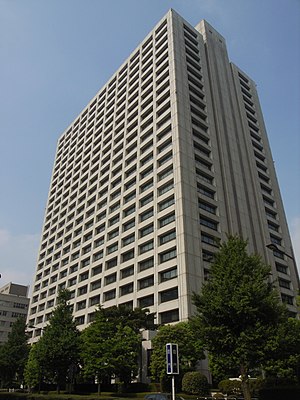Ministry of the Environment (Japan)
show This article may be expanded with text translated from the corresponding article in Japanese. (April 2012) Click [show] for important translation instructions. |
| 環境省 Kankyōshō | |
 | |
 | |
| Agency overview | |
|---|---|
| Jurisdiction | |
| Headquarters | Godochosha No. 5, 1-2-2 Kasumigaseki, Chiyoda-ku, Tokyo 100-8975, Japan |
| Ministers responsible |
|
| Parent agency | Government of Japan |
| Website | http://www.env.go.jp |

The Ministry of the Environment (環境省, Kankyō-shō) is a Cabinet-level ministry of the government of Japan responsible for global environmental conservation, pollution control, and nature conservation. The ministry was formed in 2001 from the sub-cabinet level Environmental Agency established in 1971. The Minister of the Environment is a member of the Cabinet of Japan and is chosen by the Prime Minister, usually from among members of the Diet.[1][2]
In March 2006, the then-Minister of the Environment Yuriko Koike, created a furoshiki cloth to promote its use in the modern world.[3]
In August 2011, the Cabinet of Japan approved a plan to establish a new energy watchdog under the Environment Ministry,[4] and the Nuclear Regulation Authority was founded on September 19, 2012.[5]
Cool Biz[]
The Ministry of the Environment began advocating the Cool Biz campaign in summer 2005 as a means to help reduce electric consumption by limiting use of air conditioning and allowing the wearing of less formal officewear. This idea was proposed by then-Minister of the Environment Yuriko Koike under Prime Minister Junichiro Koizumi.
Super Cool Biz[]
Following the Tōhoku earthquake and tsunami in March 2011, the shut down of many nuclear power plants for safety reasons lead to energy shortages. To conserve energy, the government recommended setting air conditioners at 28 degrees Celsius, switching off computers not in use, and called for shifting work hours to the morning and taking more summer vacation than usual. The government then launched a Super Cool Biz campaign[6] to encourage workers to wear outfits appropriate for the office yet cool enough to endure the summer heat. Polo shirts and trainers are allowed, while jeans and sandals are also acceptable under certain circumstances.[7] June 1 marked the start of the Environment Ministry's campaign, with full-page newspaper ads and photos of ministry workers smiling rather self-consciously at their desks wearing polo shirts and colorful Okinawa kariyushi shirts.[8] The campaign was repeated in 2012[9] and 2013.[10]
See also[]
| Wikinews has related news: |
References[]
- ^ "Kankyō-shō" [Ministry of the Environment]. Nihon Kokugo Daijiten (in Japanese). Tokyo: Shogakukan. 2012. OCLC 56431036. Archived from the original on 2007-08-25. Retrieved 2012-05-31.
- ^ "Ministry of Environment". Encyclopedia of Japan. Tokyo: Shogakukan. 2012. OCLC 56431036. Archived from the original on 2007-08-25. Retrieved 2012-05-31.
- ^ Minister Koike created the "Mottainai Furoshiki" as a symbol of Japanese culture to reduce wastes
- ^ http://www.japantoday.com/category/politics/view/cabinet-approves-plan-to-set-up-new-nuclear-watchdog Japan Today
- ^ Nuclear Regulation Authority index Retrieved on September 22, 2012
- ^ "Archived copy". Archived from the original on 2011-08-11. Retrieved 2019-07-08.CS1 maint: archived copy as title (link) Japan's Ministry of the Environment Official Super Cool Biz 2011 Campaign site (in Japanese)
- ^ https://www.bbc.co.uk/news/business-13620900 BBC: Japan promotes 'Super Cool Biz' energy saving campaign, June 1, 2011
- ^ https://www.japantimes.co.jp/opinion/2011/06/12/editorials/super-cool-biz/ Japan Times: Super Cool Biz, Sunday, June 12, 2011
- ^ "Archived copy". Archived from the original on 2012-09-19. Retrieved 2019-07-08.CS1 maint: archived copy as title (link) Japan's Ministry of the Environment Official Super Cool Biz 2012 Campaign site (in Japanese)
- ^ "Archived copy". Archived from the original on 2013-08-14. Retrieved 2019-07-08.CS1 maint: archived copy as title (link) Japan's Ministry of the Environment Official Super Cool Biz 2013 Campaign site (in Japanese)
External links[]
| Wikimedia Commons has media related to Ministry of the Environment (Japan). |
- 2001 establishments in Japan
- Ministries established in 2001
- Environment ministries
- Government ministries of Japan
- Energy in Japan


